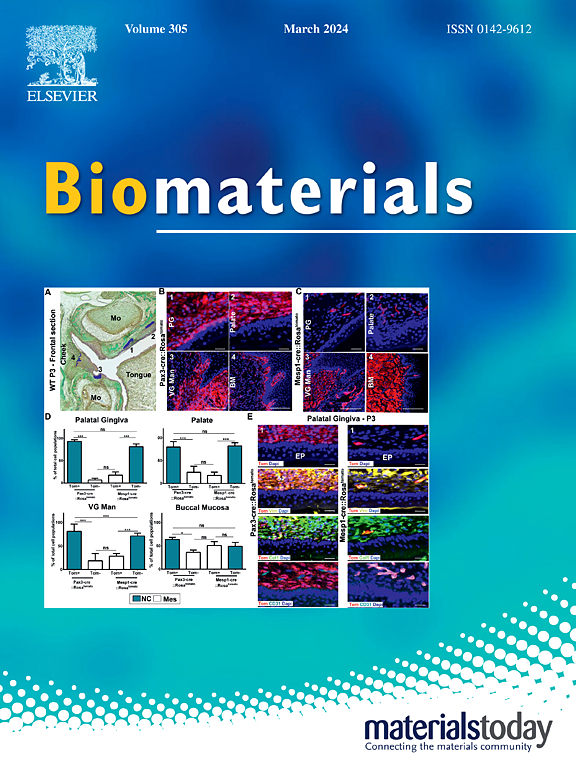The minimalist epigenetic nano-adjuvant gMSN reprograms dendritic cells to enhance the mucosal immune response of oral vaccines
IF 12.8
1区 医学
Q1 ENGINEERING, BIOMEDICAL
引用次数: 0
Abstract
Weak response is the bottleneck for subunit prophylactic vaccines to trigger efficient immunization. The emergence of highly effective adjuvants will revolutionize. Considering that genomic epigenetic reprogramming plays an important role in the immune response, we herein present an minimalist epigenetic nano-adjuvant gMSN constructed of β-glucan-modified functional mesoporous silica (MSN), which we term as OVA/gMSN after loaded with the model antigen ovalbumin (OVA). Oral administration of OVA/gMSN ensures that enough antigen reach dendritic cells (DCs) in intestinal mucosal lymphoid follicles via intestinal M cells while relying on gMSN to exhibit good adjuvant properties to trigger an effective systemic co-mucosal immune response. gMSN upregulates genes associated with aerobic glycolysis, promoting metabolic reprogramming in DCs and enhancing the expression of genes related to DC activation, cross-presentation, maturation, and migration. Simultaneously, it increases the accumulation of key epigenetic markers H3K27ac, H3K4me1, and H3K4me3. ATAC-seq results reveal enhanced chromatin accessibility of key immune genes, such as Il2rα1, Il18r1, and Cd83, in gMSN-treated DCs. This integrative molecular mechanism demonstrates that gMSN induces epigenomic remodeling in DCs after oral administration, showcasing the potential of combining epigenetic adjuvants and nanotechnology in oral vaccine design, and providing new directions and a theoretical basis for vaccine adjuvant development.
极简表观遗传纳米佐剂gMSN重编程树突状细胞以增强口服疫苗的粘膜免疫反应
弱反应是亚单位预防性疫苗引发有效免疫的瓶颈。高效佐剂的出现将带来革命性的变化。考虑到基因组表观遗传重编程在免疫应答中发挥着重要作用,我们在此提出了一种极简表观遗传纳米佐剂gMSN,该gMSN由β-葡聚糖修饰的功能介孔二氧化硅(MSN)构建,我们将其称为OVA/gMSN,并加载了模型抗原卵清蛋白(OVA)。口服OVA/gMSN可确保足够的抗原通过肠M细胞到达肠黏膜淋巴样滤泡中的树突状细胞(dc),同时依靠gMSN表现出良好的佐剂特性,触发有效的全身共粘膜免疫应答。gMSN上调与有氧糖酵解相关的基因,促进DC中的代谢重编程,并增强与DC激活、交叉呈现、成熟和迁移相关的基因的表达。同时,增加了关键表观遗传标记H3K27ac、H3K4me1和H3K4me3的积累。ATAC-seq结果显示,在gmsn处理的dc中,关键免疫基因(如Il2rα1、Il18r1和Cd83)的染色质可及性增强。这一整合的分子机制表明,gMSN可诱导口服给药后dc的表观基因组重塑,显示了表观遗传佐剂与纳米技术结合在口服疫苗设计中的潜力,为疫苗佐剂的开发提供了新的方向和理论基础。
本文章由计算机程序翻译,如有差异,请以英文原文为准。
求助全文
约1分钟内获得全文
求助全文
来源期刊

Biomaterials
工程技术-材料科学:生物材料
CiteScore
26.00
自引率
2.90%
发文量
565
审稿时长
46 days
期刊介绍:
Biomaterials is an international journal covering the science and clinical application of biomaterials. A biomaterial is now defined as a substance that has been engineered to take a form which, alone or as part of a complex system, is used to direct, by control of interactions with components of living systems, the course of any therapeutic or diagnostic procedure. It is the aim of the journal to provide a peer-reviewed forum for the publication of original papers and authoritative review and opinion papers dealing with the most important issues facing the use of biomaterials in clinical practice. The scope of the journal covers the wide range of physical, biological and chemical sciences that underpin the design of biomaterials and the clinical disciplines in which they are used. These sciences include polymer synthesis and characterization, drug and gene vector design, the biology of the host response, immunology and toxicology and self assembly at the nanoscale. Clinical applications include the therapies of medical technology and regenerative medicine in all clinical disciplines, and diagnostic systems that reply on innovative contrast and sensing agents. The journal is relevant to areas such as cancer diagnosis and therapy, implantable devices, drug delivery systems, gene vectors, bionanotechnology and tissue engineering.
 求助内容:
求助内容: 应助结果提醒方式:
应助结果提醒方式:


